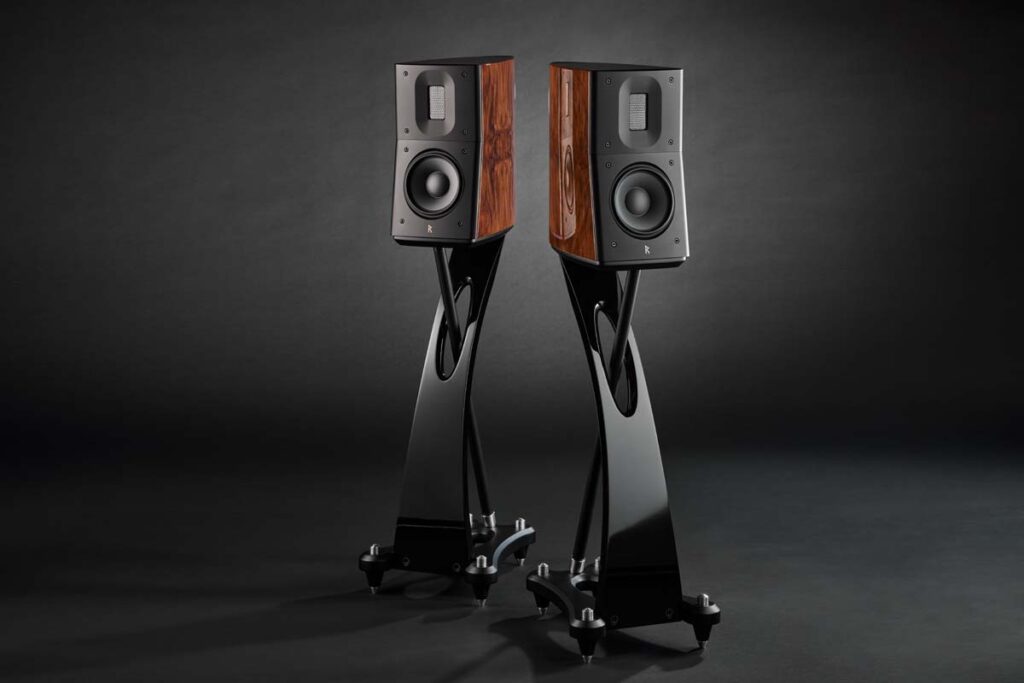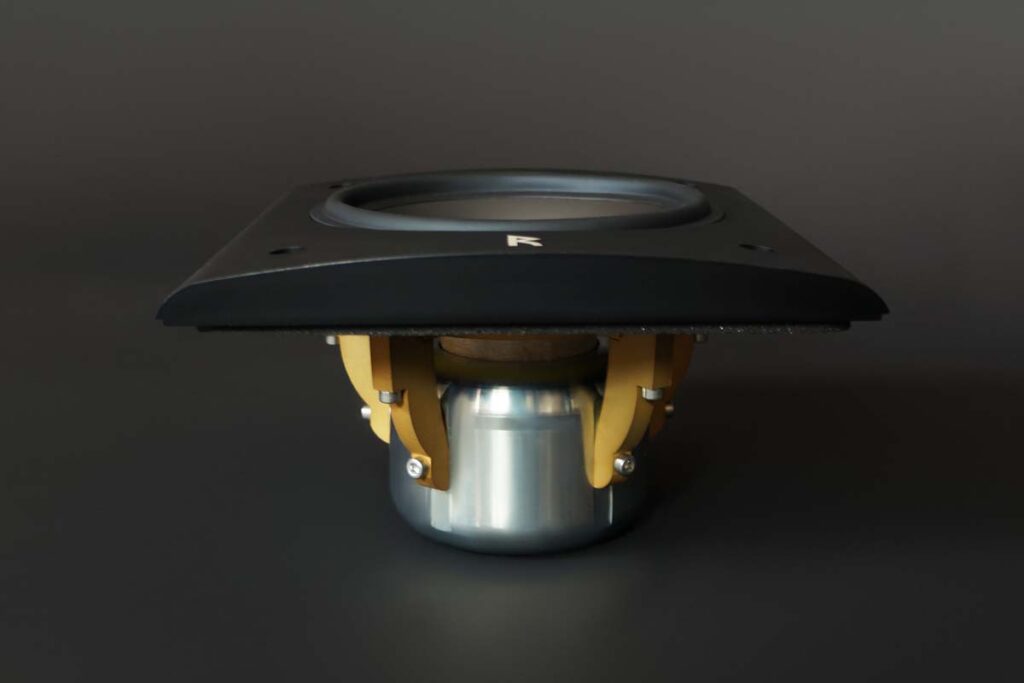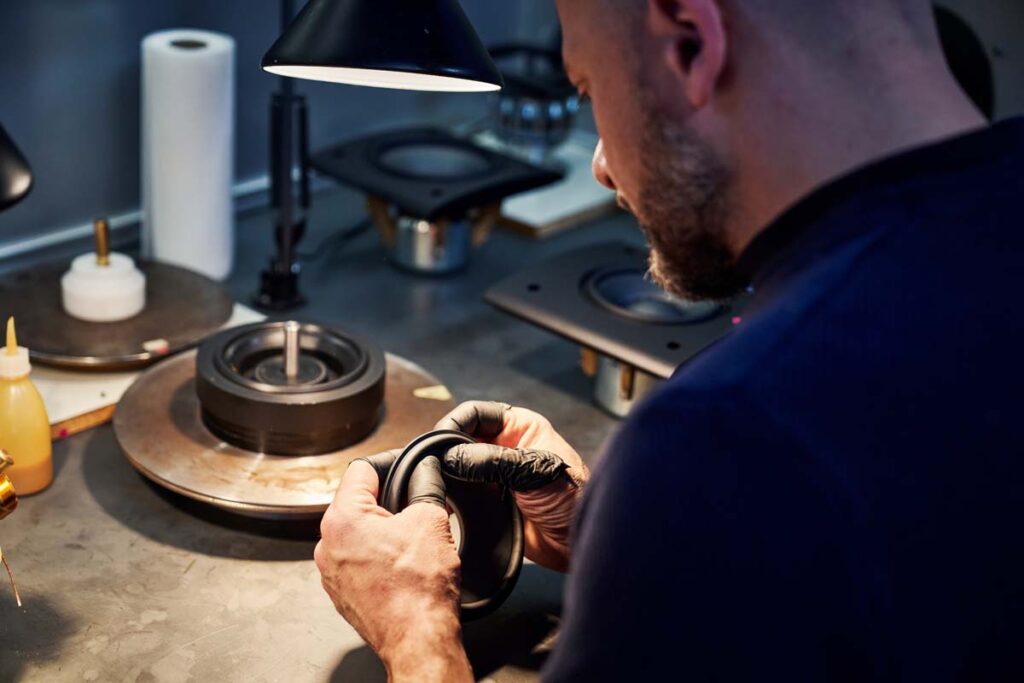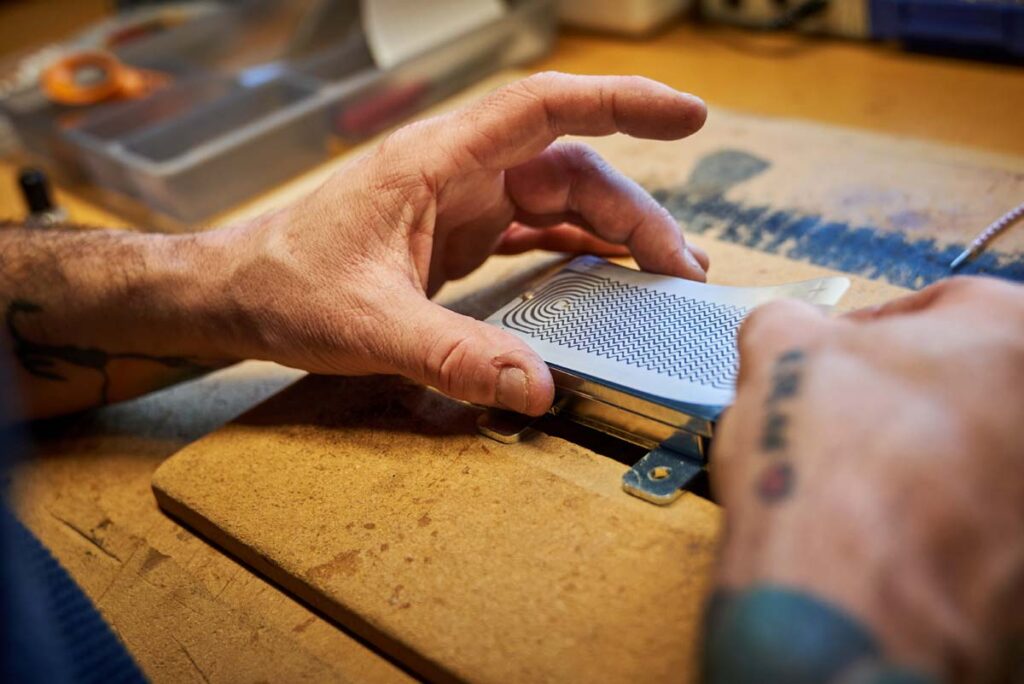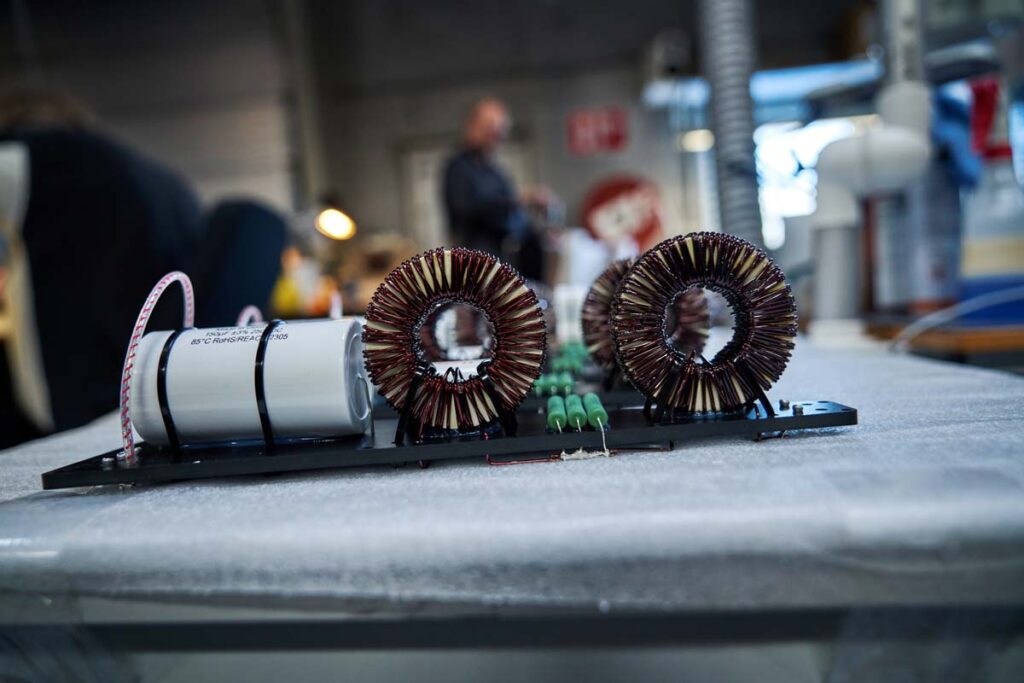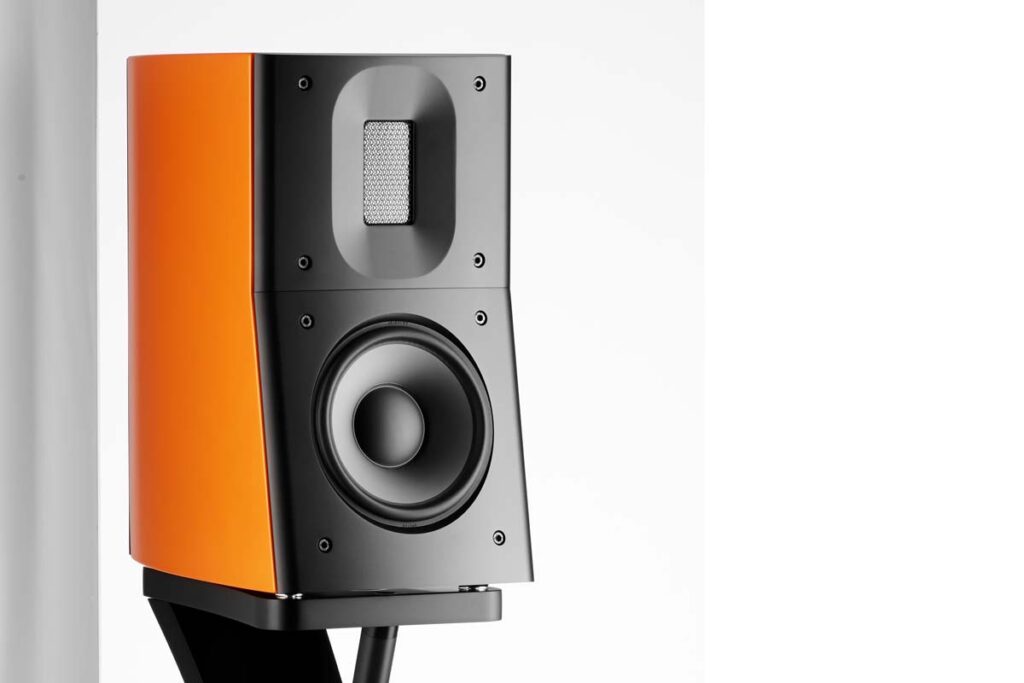As the test candidates are warming up in the listening room, a live transmission of a European Championship match is playing. Voices, a stadium atmosphere and a match that I didn’t care to remember. But what immediately stuck in my mind was how free, open and detached a human voice can sound over loudspeakers! Very free and open, in fact, when the speakers in question are called “Raidho TD1.2”. A good start to a review phase that made me eager to try actual music … if it weren’t for the price. But more on that later.
The Danish manufacturer Raidho doesn’t mince words when it comes to the supposed qualities of its TD1.2 standmount loudspeaker. It sounds twice as big as it is physically, they say; it’s just as sonically mature as a floorstanding speaker, they say. And because the latter has more components and a larger cabinet, the TD1.2 is be good value. A bold claim. But let’s get the facts on the table first.
The Raidho TD1.2 is a standmount, passive two-way bass reflex loudspeaker. The drivers were developed in-house and are manufactured in Denmark. The completely redesigned Raidho ribbon is used in the treble range. Specifically, a planar magnetic driver with an extremely low diaphragm weight of just 20 milligrams. In order to achieve optimum interaction with the new bass-midrange driver, the team led by developer Benno Baun Meldgaard (chief designer at Gamut, which is now also part of Raidho’s parent company Dantax) changed the magnetic drive, revised the waveguide and made a few other modifications. The result: three decibels more sensitivity and even less distortion than its predecessor.
The six-and-a-half-inch bass-midrange driver is completely new. Meldgaard’s team decided to use a titanium wire with a square cross-section in order to make the voice coil windings as tight as possible and without any air pockets. This voice coil is driven by a strong neodymium magnet (N52) and is positioned deeper in the magnetic field or below the magnet. The voice coil can be seen from behind through an opening in the turbine-shaped magnet drive. As with the tweeter, this should ensure even less distortion. The suspension of the tantalum-diamond cone has been designed to be as soft as possible in order to have as little influence as possible on its vibration behavior. The diamond layer consists of 1.5 carats of artificial diamond!
In order to make both drivers mesh, the TD1.2 has also been given a new crossover compared to its predecessor, the D1.1. This is hard-wired and, as in the entire speaker, Nordost cables are also used in the crossover. Among other things, the cables connect the Mundorf components used. The entire crossover is made by hand in Denmark. Incidentally, the tweeter takes over from 2.4 kilohertz.
Sting stands freely between the loudspeakers in the listening room, yet very much within the context of the band. “Loving You” from his latest album The Bridge only has a real bass in the chorus; in the other passages, the bass drum takes over the low-frequency part of the production. This increases the dynamics of the song. The individual passages stand out better from one another, especially as the harmonic structure of the song remains the same from beginning to end. The TD1.2s convey this with great confidence, in fact, the speaker seems acoustically larger than it actually is. I set it up on the matching, lightweight and springy stands at a slight angle to the listening position. The bass reflex tube at the rear is fitted with two “wings”, which are intended to minimize flow noise and, from my listening experience, do so effectively. I mention this here because the sheer sonic size of the TD1.2 is of course also due to this bass reflex principle. The result is that the bass range always sounds powerful and clean, but sometimes the finest tonal details of a bass line are not quite clear. The energy content in this frequency range is absolutely right and convincing, but I cannot fully understand the exact pitch of individual bass notes via the compact loudspeaker. Don’t take this as a criticism, this is a design-related phenomenon that even this very well-designed loudspeaker cannot circumvent. And in my opinion, this is also the main difference to a floorstanding loudspeaker.
What the Raidho TD1.2 can do excellently is the spatial reproduction of the band or orchestra. Voices are confidently placed in the room and detached from the loudspeakers and are – thank you, Raidho! – realistically large! There is no exaggeration here in favor of a wow effect, but the Raidhos remain musically neutral without any discernible coloration. The detail on display is simply fantastic. For example, I can hear the finest details in cymbals or when plucking an acoustic guitar, as well as production elements, in high resolution and with actual presence. This is not due to an overemphasis on high frequencies, but simply to the Danes’ outstandingly good tweeter.
I run the Raidhos on various amplifiers, from mono power amplifiers to integrated transistor amplifiers to a tube amplifier. With their now quite decent 87 decibel efficiency (2.83 V/m), they also cut a fine figure on the latter. Subjectively, the fine details in the high frequencies come out even better here, although it always took me a few moments to rewire the devices.
Iva Davies’ (Icehouse) version of “All Tomorrows Parties” with sonorous, overriding vocals and powerful, low toms makes a big impression and is a lot of fun even at lower volumes. Incidentally, this is another advantage of the Raidho TD1.2: they play big and mature even at moderate volumes. All listening experiences to date suggest that the Danish speakers should also work well with classical music. I choose Ralph Vaughan-Williams’ Third, the Pastoral Symphony, with the Bournemouth Symphony Orchestra under Kees Bakels. The body of sound unfolds between the loudspeakers and the dynamics of this work are conveyed directly. In the context of the concert hall, the solo brass is located at the back left with some reverberation, the strings sound well staggered in the middle and the wood is easy to hear even in tutti passages. Not even the turning of the music sheet pages remains hidden from the listener, once again emphasizing the acoustic characteristics of the recording venue. Of course, this ability depends on the quality of the recording as much as the playback chain.
In typical Raidho fashion, the bass-midrange driver is mounted on a part of the baffle that is angled slightly upwards. The tweeter radiates straight into the room. The housing, which tapers towards the rear, has a high-gloss lacquered wood veneer on the outside, while the rear panel with the bass reflex tube and the (single-wire) terminal, like the front, is made from a molded part. The workmanship is good all round and there is nothing to complain about. The high-gloss stands are swinging constructions so that they can move from front to back. However, due to the lightweight design and the fact that the speakers are placed on a single plate with a relatively high center of gravity without fixation, care should be taken when sorting and cleaning in the listening room.
The Raidho TD1.2 is positioned in the top price bracket for two-way standmount loudspeakers. The precision in the spatial representation of the sound sources is unprecedentedly good and the bass foundation also sounds mature – even at low volumes. However, not even the sophisticated driver technology can outwit physics. In this price range, the Danish speaker has to assert itself against equally great-sounding competitors. Although I have to say – three Karat never sounded better to me.
Accompanying Equipment
CD player/DAC: Luxman D-N150 | DAT recorder: Tascam DA-20 | Turntables: Elac Miracord 70, Rega Planar 3 | Cartridges: Audio-Technica AT33PTG/II, Audio-Technica VMN50SH | Phono preamplifier: Luxman E-250 | Preamplifier: Linn Majik | Integrated amplifier: Luxman SQ-N150, Linn Majik | Power amplifier: Graham Slee Proprius (mono) | Loudpeakers: Klipsch Heresy IV | Cables: Ecosse, Supra, Graham Slee, TaraLabs, Furutech
Raidho TD1.2 Loudspeakers
Concept: 2-way standmount loudspeaker with single-wire terminal, bass reflex | Inputs: single-wire for banana plugs | Equipment: Raidho TD ribbon (tweeter), 6.5” bass driver (17 cm, sandwich cone with tantalum and diamond coating) | Crossover frequency: 2.4 kHz | Bandwidth (-3 dB): 45 Hz to 50 kHz | Impedance: 6 Ω | Sensitivity (2.83 V/m): 87 dB | Recommended power: 25 to 125 W | Special features: no front cover, English operating instructions, stand optional | Finishes: Black, RAL colors or walnut veneer, high-gloss lacquer | Dimensions (W/H/D): 20/36/40 cm | Weight: 13 kg | Warranty period: 2 years | Price per pair: from €20,500, speaker stand around €2,500
DANTAX Radio
Bransagervej 15
9490 Pandrup
Denmark
Phone +45 9824 7677
sales@raidho.dk



